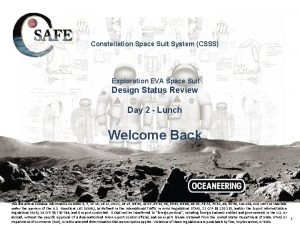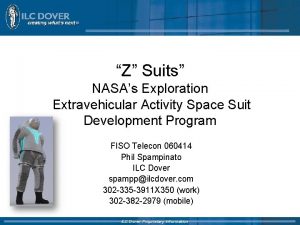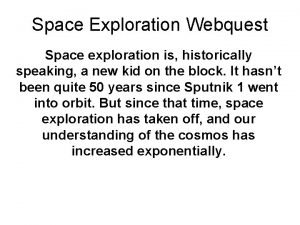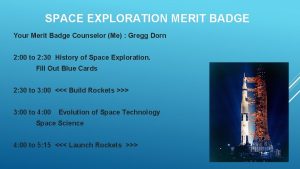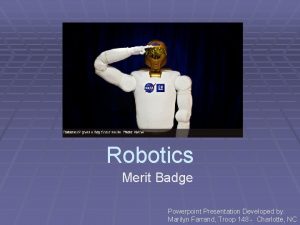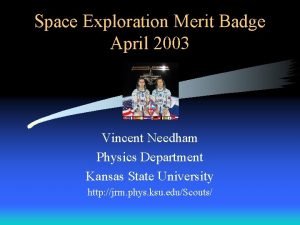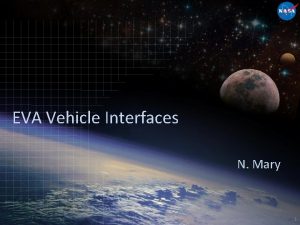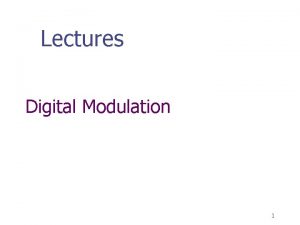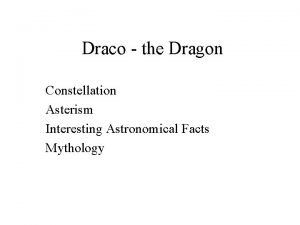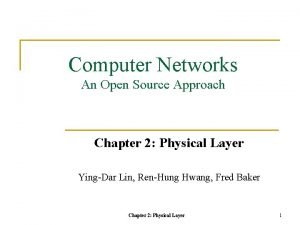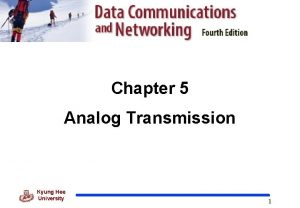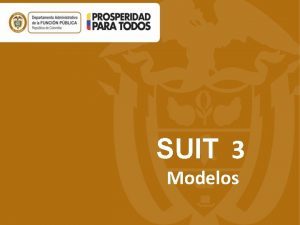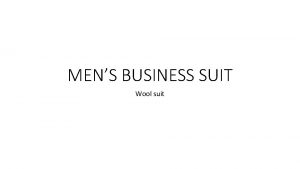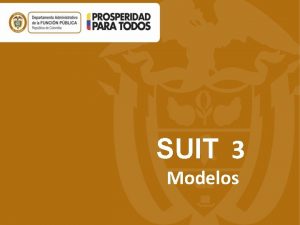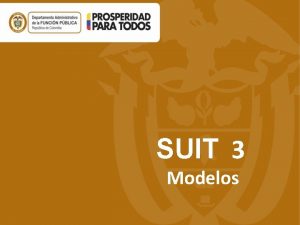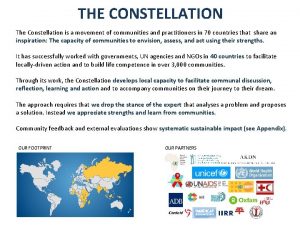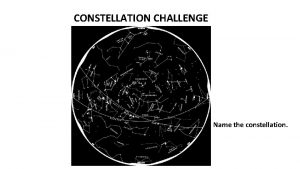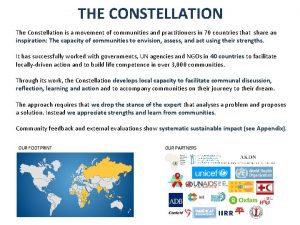Constellation Space Suit System CSSS Exploration EVA Space



















- Slides: 19

Constellation Space Suit System (CSSS) Exploration EVA Space Suit Design Status Review Day 2 - Lunch Welcome Back Export Control Notice This document contains information on slides 4, 7, 12 -13, 16 -17, 20 -21, 23 -27, 33 -39, 42 -47, 49 -54, 56, 59 -61, 63 -66, 68 -70, 73 -74, 79 -82, 86, 95 -96, 102 -106, and 109 -110 that falls under the purview of the U. S. Munitions List (USML), as defined in the International Traffic in Arms Regulations (ITAR), 22 CFR §§ 120 -130, and/or the Export Administration Regulations (EAR), 15 CFR §§ 730 -744, and is export controlled. It shall not be transferred to “foreign persons”, including foreign business entities and governments in the U. S. or abroad, without the specific approval of a duly-authorized NASA export control official, and an export license obtained from the United States Department of State (ITAR) or 1 Department of Commerce (EAR), or a documented determination that an exemption applies. Violations of these regulations are punishable by fine, imprisonment, or both.

Life Support Subsystem Vent and Thermal Loop New Suit New Team New Journey Suit / Umbilical Recharge Connectors and Whip Presented by Jay Barton 8 -26 -2015 94

SRC, URC and Whip – Overview • Suit Recharge Connector • Umbilical Recharge Connector • • Supports pre- and post-EVA operations – Vacuum connection for CO 2 scrubbing and humidity control while EVA and on umbilical – Water lines for thermal control – Wiring for communications, data, and power – High pressure O 2 recharge Provides capability to recharge water and oxygen at the airlock while EVA Whip provides fluid and power / data interfaces between PLSS and umbilical and between PLSS and PGS-mounted hardware SRC / URC is interface between whip and umbilical – Mass and Dimensions (not including hose bundles or PTT switch) – SRC is 1. 6 lbm, 4. 0" x 4. 7” x 2. 1” – URC is 2. 3 lbm, 6. 2” x 4. 8” x 3. 4” mated, and 4. 6” x 4. 8” x 6. 1” demated Mated URC and SRC [Includes ITAR controlled information- see Cover Slide for instructions] 95

SRC, URC and Whip – Location in Schematic HPO 2 Tank Recharge URC Vacuum Access Water From Suit SRC Power / Data Connection Water To Suit Whip [Includes ITAR controlled information- see Cover Slide for instructions] 96

SRC, URC and Whip – Location on Suit Whip SRC mounts to center front torso and whip extends from SRC, under left arm, into PLSS above left shoulder 97

SRC, URC and Whip – Leading Requirements • • UMB. 046 UMB. 110 UMB. 001 UMB. 328 Unassisted Operations HPO 2 Maximum Expected Operating Pressure Umbilical External Interfaces Push-To-Talk Switch Accessibility 98

SRC, URC and Whip – Design Drivers • • Consumables recharge Vacuum interface with good vacuum conductance for desorb cycle Ease of use, operable at suit MEOP without assistance Integration with suit (meet mobility requirements and not conflict with suit real estate demands) Interface with ISS while also meeting exploration requirements Low pressure drop for fluid loop Minimal leakage 99

SRC, URC and Whip – Architecture Overview • Architecture features – Ganged connector – EVA compatible handle – Water bypass to complete thermal loop when umbilical is demated – Vacuum exhaust and interface for Swing Bed Scrubber Views illustrating ganged connector operation by suited subject 100

SRC, URC and Whip – Details • • • Mating Mechanisms – URC handle twist engages face seals, O 2 connector, and electrical connectors – Handle fold provides torque for SRC valve actuation – Pins provide alignment for Recharge Umbilical Contains Key Functional Fluid Features – Seals via cartridge valves with redundant critical seals – Interlocks prevent inadvertently venting fluids Integrated HPO 2 capability Vacuum exhaust and access Cable covers provide protection for electrical connectors SRC un-mated URC un-mated 101

SRC, URC and Whip – Details • • Vacuum exhaust and access – SRC has full 1” vacuum vent since that port is used during entire EVA to vent CO 2 – URC has 5/8” vacuum vent, since we can cycle the scrubber beds faster while mated – SRC includes a softgoods Non. Propulsive Vent cover HPO 2 Quick Disconnect pair provided by Preece – Based on military and ISS 9100 style QDs – Increased pressure capability – Added backup seals – Miniaturized design URC’s 5/8” vacuum port, radial o-ring, and face seal SRC’s 1” vacuum ports SRC / URC with small amount of separation before mating Preece HPO 2 Quick Disconnect [Includes ITAR controlled information- see Cover Slide for instructions] 102

SRC, URC and Whip – Details • Whip Features – HS-80 Hydraflow hoses (conductive PTFE, good flexibility) – Parker HP O 2 hose (aerospace, SS braided, flexible, AS-4395 connectors) – SRC Hoses and cables routed from center torso, under arm, to PLSS. Service loop provided to aid hatch opening – TMG is buildup of Orthofabric, Armalon, and polyester. – Umbilical-mounted Push-to-Talk switch allows PTT operation over hardline communications loop • Switch is mounted to umbilical near URC since only used while attached to umbilical • Frees up real estate on suit during EVA PTT switch fixture and placement on umbilical PTT switch access [Includes ITAR controlled information- see Cover Slide for instructions] MIL-Spec PTT switch 103

SRC, URC and Whip – Details • Electrical bonding and grounding and connectors and cables Cable routing cavities and channels Overall braided shield folded back over outer sleeve, provides 360 degree overall shielding Individual shields wrapped with drain wire, lug terminal crimped to drain wire fastened to connector body Using Glenair Mighty Mouse 803’s in a 9 shell size. 7 -20 AWG pins for power, ground, and spares. 13 -22 AWG pins for ethernet, audio, PTT, shield signal, and spares. Longer alignment post makes contact with receptacle sooner New cable covers with strain relief features *Conductive o-rings being assessed for grounding use [Includes ITAR controlled information- see Cover Slide for instructions] 104

and Whip SRC Asse mbly Note s 1. Alumin um parts a re anodized 2. Redun dant critica l seals 3. Stainle ss passiva ted 4. Vitro lu be used on wear surfaces 5. MIL-DT L-38999 S eries II electrical c onnectors 6. Alumin um conduc tive surfaces a re chem conversion coated – Details Water valv e cartridg ew/ bypass an d drive ge ar Interlocks HPO 2 QD Electrical cable covers SRC Body Electrical connectors Electrical cable covers HPO 2 Hos e connectio n Hose rete ntion clamps Nut and load pins SRC Asse mbly [Includes ITAR contr o lled inform ation- see Cover Slid e for instru ctions]

SRC, URC and Whip – Details URC Assembly Notes 1. Aluminum parts are anodized 2. Redundant critical seals 3. Stainless passivated 4. Vitro lube used on wear surfaces 5. MIL-DTL-38999 Series II electrical connectors 6. Aluminum conductive surfaces are chem conversion coated Electrical connectors HPO 2 line and fittings Electrical cable covers HPO 2 fitting Vacuum cartridge (right side) and water valve cartridge w/ bypass and drive gear (left side) URC Body Hose retention clamps T-handle post and grip Interlocks Locking sleeve HPO 2 QD Pulldown post and ‘bullnose’ alignment feature URC Assembly [Includes ITAR controlled information- see Cover Slide for instructions] 106

SRC, URC and Whip – Concept of Operations • • • Umbilical will be connected to the vehicle interface with a modified UCM It is assumed that the vehicle will provide a vacuum connection – CO 2 removal will be provided by the PLSS CO 2 scrubber through the umbilical while the suit is pressurized (may cycle faster due to smaller line size) URC and SRC will be mated / demated unpressurized – HPO 2 line will be vented on the vehicle side (vents the HPO 2 line up to the PLSS check valves CK-802 a and b) – After venting the HPO 2 line, O 2 and power are turned off at the vehicle interface When airlock is depressurized and crew is ready to go EVA: – tether hook and umbilical are demated and restrained in the airlock – crew installs the URC and SRC protective covers (and periodically verify) to prevent damage and thermal excursions during the EVA The above operations are performed in reverse for mating, and forward for demating asneeded for recharge during EVA and / or when the EVA is complete Between EVAs the umbilical may be left attached for some time to permit full recharge of suit systems 107

SRC, URC and Whip – Supporting Data • SRC and URC are based on an LEA version developed to TRL 6, though PDR. – PDR and Design Status Review included Thermal / Stress / EEE Parts / EMI/EMC / Vibration / Condensation / Permeability Analyses, Mechanisms Systems Working Group Reviews, White Sands Oxygen Compatibility Assessment (OCA) Reports, Reliability / Hazard / FMEA/CIL / Fault Tree Analyses – 3 generations of hardware – Tests include: crew evaluations, thermal/vacuum, vibration, proof pressure, pressure drop, leakage, crush loads, flexibility, lifecycle – Human-in-the-Loop (HITL) Tests – Orion Integration, Human Engineering, support of pressure garment HITL testing, Anthropometry and Biomechanics Facility, Human Engineering Structural Mockup, Ambient Pressure Integrated Suit Test, Oceaneering Suit Lab 11 foot IVA Umbilical and Suit Multiple Connectors Human-In-The-Loop Testing 108

SRC, URC and Whip – Supporting Data • Real Estate Evaluations – Objective: Evaluate placement and operation of SRC and whip on suit, and interfaces with other hardware – 2014 Whip Evaluations (TDS 1185) • Suited, unpressurized tests with mock-up torso • Determined optimal location for SRC, MSPV, pressure gauge, and SCA based on suited subject and NASA crew inputs • Whip hose routing was also determined based on these detailed engineering evaluations – 2015 Preliminary PXS Real Estate Evaluation • Confirmed that standard configuration (vertical SRC) was the right choice to move forward with – Full-up suit model and initial PXS testing • Predicted some mobility issues that drove redesign of mounting hardware • Latest mounting HW is now being integrated and evaluated in pressurized testing (forward work from TDS 1185) Real estate and whip routing Horizontal SRC Vertical SRC / SCA / MWS placement in model 109 [Includes ITAR controlled information- see Cover Slide for instructions]

SRC, URC and Whip – Supporting Data • • Hose evaluations prior to IDR and in 2014 – Objective: Select optimal choices for low and high pressure hoses – Hydraflow HS-80 for lower pressure fluids and gasses (and vacuum line) – Parker Stratoflex 171 for HPO 2 provided best flexibility and dimensional stability scores Electrical cables market survey (2015) – Objective: Review electrical cables and determine a path to flight for electrical cables – Cables used on PXS version of the SRC / URC are a non-custom variation that is promising [Includes ITAR controlled information- see Cover Slide for instructions] 110

Umbilical – Driving Requirements Key Driving Requirements EXS Spec Issues Y/N Supporting Data (Test/Analysis Rpt, Heritage, etc. ) UMB. 011 IVA Contact Loads EXS. 0011 N TDS: 1007, 1014 UMB. 046 Unassisted Operations EXS. 0046 N TDS: 1054, 1054 A UMB. 110 HPO 2 Maximum Expected Operating Pressure (MEOP) EXS. 0110 N TDS: 1006, 1076 UMB. 111 Umbilical HP O 2 Leakage When Attached EXS. 0111 to Vehicle N UMB. 113 Umbilical Cooling Water Leakage When Attached to Vehicle EXS. 0113 N TDS: 1006 UMB. 126 Push-To-Talk Signal EXS. 0254 N TDS: 1006, 1071 UMB. 171 Continuous On-orbit Service Life EXS. 0171 N TDS: 1031, 1035, 1076, 1249 UMB. 324 HP O 2 Pressure Rise Rate EXS. 0324 N UMB. 001 Umbilical External Interfaces Multiple EXS N UMB. 328 Push-To-Talk Switch Accessibility EXS. 0254 N TDS: 1071 UMB. 062 Umbilical Dry Mass EXS. 0353 N TDS: 1148 UMB. 076 Tool Free Umbilical Device Actuation EXS. 0076 N TDS: 1002, 1205 111
 Constellation space suit
Constellation space suit Zsuits
Zsuits Space suit parts
Space suit parts Space exploration webquest
Space exploration webquest Space exploration webquest answer key
Space exploration webquest answer key Benefits stemming from space exploration
Benefits stemming from space exploration The father of modern rocketry
The father of modern rocketry Robotics merit badge answers
Robotics merit badge answers Http://history.nasa.gov/sputnik/
Http://history.nasa.gov/sputnik/ Space exploration merit badge powerpoint
Space exploration merit badge powerpoint Deep space exploration society
Deep space exploration society Suitport
Suitport Constellation defintion
Constellation defintion M-ary psk
M-ary psk Mazzaroth
Mazzaroth Draco asterism
Draco asterism Ursa major facts
Ursa major facts Smallest constellation
Smallest constellation Ask modulation constellation diagram
Ask modulation constellation diagram Constellation diagram bpsk
Constellation diagram bpsk
